One of the most iconic structures in North America, and the number one tourist attraction in San Francisco, the Golden Gate Bridge opened to the public in 1937.

It connects San Francisco to California’s northern counties and spans almost two miles across the Golden Gate, the narrow strait where San Francisco Bay opens to the Pacific Ocean. It has tremendous 746-foot tall towers, Art Deco styling, and signature International Orange color. If you plan to visit, be ready for crowds because the bridge sees about 10 million visitors yearly.
Royal Gorge Bridge, Colorado
Not only is this bridge the highest suspension bridge in the U.S, but it also has some historical significance. It was constructed in 1929, however, only after fifty years were stabilizing wind cables added. The bridge crosses 955 feet above the Arkansas River. It held the title of the World’s tallest bridge until 2001 when China surpassed it with the Liuguanghe Bridge.

Today, it is a tourist attraction located near Canon City, Colorado. The bridge is located within Royal Gorge Bridge & Park, a 360-acre amusement park. Brave visitors can choose even to ride a cable car which will immerse them in a 360-degree view of Colorado’s most stunning scenery.
Monkey bridges, Vietnam
This is definitely not your modern-day bridge. This bridge crosses over the Mekong Delta. Like other monkey bridges scattered throughout Vietnam, It was handmade from a single piece of bamboo log. While it looks like something only an animal would walk across, locals actually use them all the time. It is a unique Vietnamese traditional symbol that gets its name because of the silly way in which people move their bodies while crossing.

These bridges can be difficult and dangerous for people who are not accustomed to them. However, locals who use the bridges all the time, have been known to carry on 20–50 kg while crossing the bridge. Must we say, do not try this at home?
Hussaini Hanging Bridge, Pakistan
Claimed to be the most dangerous bridge in the world, this bridge is one of the many hazardous rope bridges in Northern Pakistan. The bridge crosses over Borit Lake in the Upper Hunza

It is terrifying for a number of reasons. First of all, a fall through this rickety gap-filled swinging bridge would have you flying into the Hunza River down below. Secondly, the bridge is poorly maintained and strong winds vigorously shake it as you walk across. Finally, when you are crossing the bridge, you see the ragged remains of the previous bridge still hanging in tatters next to the newer bridge. The bridge has become somewhat of a tourist attraction, with hikers testing their courage as they carefully shuffle their way across.
Seven Mile Bridge, Florida
This is the second 7-mile bridge, the first one was taken down because it prevented boats from passing through due to its direct position in the water. It is located in the Florida Keys and connects Knight's Key in the Middle Keys to Little Duck Key in the Lower Keys.

At the time of its construction, it was one of the longest bridges in the world. The bridge has won 8 awards, amongst those, the Exceptional Award for Cost Savings Innovation from the Federal Highway Administration. While it doesn’t look so scary, it is about the last place I would want to be during a Florida hurricane.
Deception Pass Bridge, Washington State
This foggy bridge which is 180 feet above the water would definitely be terrifying to walk across. The two bridges connect Whidbey Island and Fidalgo Island. Prior to the formation of the two bridges, the only way to reach the islands was by ferry. In the early 1900s, locals had to travel with their horse-and-buggy using an unscheduled ferry to cross from Fidalgo Island to Whidbey Island. In order to call the ferry, they would bang a saw with a drumstick and then sit and wait for the ferry to arrive.
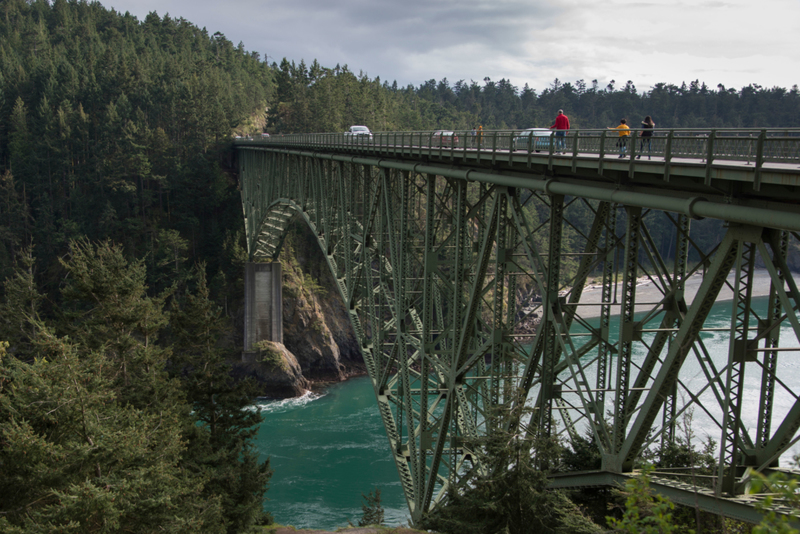
The bridge is one of the scenic wonders of the Pacific Northwest. I hope that the ferry ride is still available because I’m not sure I would want to take the bridge…
Lake Pontchartrain Causeway, Louisiana
This is the longest and one of the scariest bridges in the world. It sits only 16 feet above the choppy waters of the Pontchartrain Causeway below. The longer of the two bridges stretches 23.83 miles long. It has held the record as the longest bridge over water in the world since 1969.

Its construction greatly assisted the economy of surrounding small North Shore communities by reducing drive time into New Orleans by up to 50 minutes. The communities now have much better access to the Metropolitan city.
Canopy Walk, Ghana
Suspended 40 feet in the air, this bridge will put a nice twist on your typical rainforest walk. It’s a nice (but scary) way to get up close with nature; with the trees, monkeys, and birds. The bridge is located in the tropical jungle of Kakum National Park, but the bridge was actually constructed by a few Canadians. It was designed in an appealing way in order to bring more tourism to the park.

The walk consists of seven separate bridges that hang 130 feet above the ground. Don’t worry, while the bridges look to be like the traditional rope bridges, they are actually very sturdy and made from rope, aluminum, wooden planks, and equipped with safety netting.
Langkawi Sky Bridge, Malaysia
This bridge is 400 feet above the ground and has been closed several times for maintenance purposes. Its reopening was delayed several times but it is now open for use.

Although I still find it freaky that the bridge was closed for two years. Apparently, as was the rumor in Langkawi, the bridge can potentially collapse.
Mount Titlis, Switzerland
How would you feel walking across a bridge at 3,000 meters above the ground with a backdrop of the Swiss Alps? Terrified? Well, that sounds about right! The Titlis Cliff Walk, which is the highest elevation suspension bridge in Europe, opened in December 2012, giving views across the Alps.

Luckily, the bridge is super safe and tons of skiers and visitors cross the bridge every year.
Vitim River Bridge, Russia
This bridge looks pretty sketchy. The bridge is an old train bridge that crosses the Vitim river. There aren’t any barriers and many of its rotting wooden planks are missing.

To make matters worse, the structure is often slippery due to ice in the area, leaving drivers to dangerously navigate this narrow six-foot-wide path at their own risk. Not many people have crossed this rattly bridge with success but many daredevils flock to Siberia every year to try.
Puente de Ojuela, Mexico
Once used by the mining town below, today the bridge is for pedestrians.

It was completed in 1898 and restored as a tourist attraction in 1991. Tourists flock to this bridge because of its reputation as being one of the most dangerous roads in the world.
Quepos Bridge, Costa Rica
Also known as the “Bridge of Death,” or “Oh My God bridge” this bridge is one to be crossed at your own risk. The bridge was constructed by the Bananera Company from 1930-1940 for the train that moved bananas to the port of Quepos.

While it doesn’t look like it could even support the weight of a car, trucks actually cross it on a daily basis, and somehow they survive. The bridge is extremely narrow and allows cars to travel only in one direction. The planks don’t run across the entire bridge and clank loudly under the weight of vehicles. We think it’s time for some renovation.
Sunshine Skyway Bridge, Florida
The Bob Graham Sunshine Skyway Bridge, known by locals as the Sunshine Skyway Bridge, crosses Tampa Bay with a total length of 21,877 feet!

The original bridge was destroyed in 1980 after a massive ship ran into a pier and killed 35 people. This newer bridge was built in 1987. Sadly, more than 200 people have used the bridge to take their lives here.
Eshima Ohashi Bridge, Japan
Are you a fan of rollercoasters? Then you might enjoy this Japanese bridge. While it isn’t as steep as it looks with a gradient of 6.1 percent and a height of 144 feet, I still wouldn’t want to drive up or down that thing.

The bridge was built from 1997 to 2004. It is the largest rigid-frame bridge in Japan and the third largest in the world.
The Bridge of Immortals, Huang Shang China
If you’re afraid of heights then this bridge is one you’ll want to avoid. Situated in Huangshan (also known as Yellow Mountain) in eastern China, the bridge is situated between two giant granite peaks that scream for daredevils to cross its path.

It has spectacular views of the mountains. We imagine that the way to the bridge is perhaps even scarier. The Yellow Mountain is an adventure Thrillist's dream destination for the experience of a lifetime.
Montenegro Rainforest, Costa Rica
This is a serene and beautiful walk amongst the trees in one of the world’s most eclectic rainforests. The hanging bridges bring visitors up close and personal with the Costa Rican rainforest.

But don’t let the beautiful landscape distract you from looking down. There are missing planks in the bridge, so be cautious and watch your every step.
Storseisundet Bridge, Norway
With a backdrop of the mountains behind it, this road is spectacular yet also a bit nauseating. The bridge has been described as “The road to nowhere”.

It is one of the country’s official national tourist routes. So, if you’re a fan of the stomach drop feeling on roller coasters, you will probably enjoy this bridge.
Carrick-a-Rede Rope Bridge, Northern Ireland
Some people who cross this 66-foot-long bridge to see the beautiful island on the other side are so frightened by its position 30 meters above rugged rocks and water that they choose to ride a ferry on the way back instead. We don’t blame them.

The bridge also has a crossing toll. Apparently, paying to be scared is a thing in Ireland.
Sidu River Bridge, China
The current reigning champ of the highest bridge in the world is the Sidu River Bridge in China. This steel bridge which was built in 2009 for $100 Million hangs a nauseating 1,600 feet above the canyon floor and 5,000 feet across the river valley.

The bridge was part of China’s ongoing highway expansion project and connects two separate parts of the country that were formerly inaccessible due to mountainous terrain and several rivers. The views of the valley down below are truly staggering. Fortunately, they say it is one of the sturdiest bridges ever built. We just hope they are right.
Mekong River Crossing, China
The Mekong river is a massive river that stretches across six different countries in Southeast Asia- China, Burma, Laos, Thailand, Cambodia, and Vietnam.

The river water’s condition can fluctuate from calm to raging rapids. This picture features a woman walking across extremely choppy waters.
Millau Viaduct, France
The Millau Viaduct is recognized as the tallest bridge in the world and the largest cable-stayed bridge in Europe. It stands a whopping 1,125 feet above its base. It crosses the Gorge Valley of Southern France. It stretches over 8,000 feet long and 105 feet wide.

Its construction began in 2001 and was finished in 2004. Due to potential winds of up to 151 kilometers per hour, side screens were installed to reduce the effect of the wind by 50%. In 2006, it won the Outstanding Structure Award from the International Association for Bridge and Structural Engineering.
Iya Kazurabashi Bridge, Japan
You can see everyone in this picture holding on for dear life to the Iya Kazurabashi vine bridge of the Iya Valley which dates all the way back to the 12th century. It sits high above the Iya-gawa river in Tokushima, Japan.
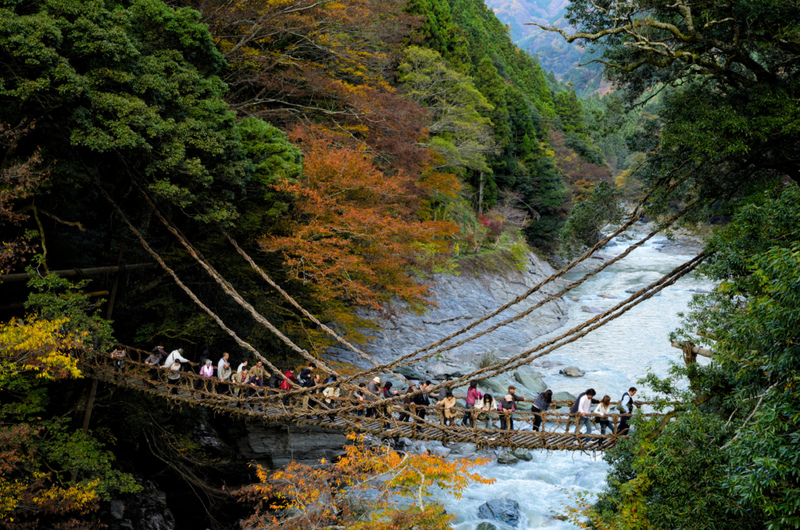
It is made of wooden planks and connected with mountain vines. While historically this bridge is very significant, maybe the safety in modernization and renovations need to be considered. Cross the bridge at your own risk, just be sure to hold on tight.
Mystery Bridge, Indonesia
We are not sure why anybody is even crossing this bridge at all. Can it even still be called a bridge it’s hanging on its side and barely in one piece anymore.

This bridge can be compared to an ‘Indo Board’ which is a device used by surfers and skateboarders in order to develop balance. they balance a wheelless board on a foam cylinder without touching the floor. in comparison, a professional ‘indo-boarder’ wouldn’t get very far on this bridge in Indonesia. These school children surely don’t seem to be bothered by it.
Trift Bridge, Switzerland
This Bridge’s beauty is apparent to all; those afraid of heights and not. It suspends 558 feet over the glaciers of Switzerland and 328 feet above sea level. It is located near the town of Gadmen in the Swiss Alps.
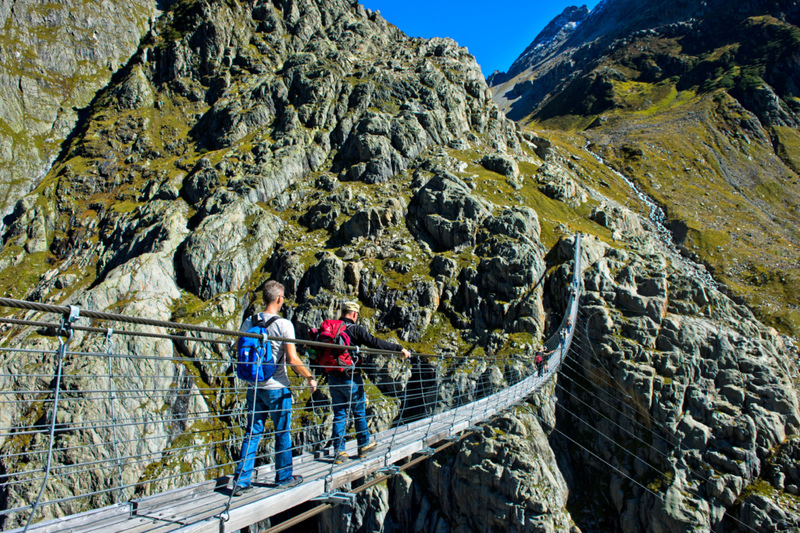
The bridge was built in 2004 but had a problem upholding very windy conditions. Fortunately, they decided to add stabilizing cables in 2009 to ensure safer conditions for those daring enough to cross the bridge on foot.
Hanging Bridge Of Ghasa, Nepal
Like many crossings in Nepal, the hanging bridge of Ghasa is used by both humans and animals alike. The bridge has been used for decades, despite its questionability under rainy and windy conditions.

On a daily basis, donkeys and cattle travel across the bridge hanging very high about the river valley. The river, fortunately, has high side rails which protect those who are brave enough to travel across.
U Bein Bridge, Burma
Stretching over the Taungthaman Lake, the U Bein Bridge was built in 1850. It is made from a tropical hardwood called teak and is believed to be the oldest bridge made out of that wood. The bridge is very dangerous as there are no side rails and nothing to hold on to as you walk (or crawl from fear) across its 1.2 km.

Not only do you have to worry about falling, but the bridge has also become a crime hotspot in recent years due to its tourist appeal. There are now policemen guarding the bridge as protection for tourists and passersby.
Root Bridges, India
The world can learn a thing or two about these bridges which aren’t built, yet grown from materials found in nature for their construction. The bridges used the tangled roots of the Ficus elastica tree, a rubber tree that is found in the southern Khasi and Jaintia hills and produces secondary roots from higher up its trunk.
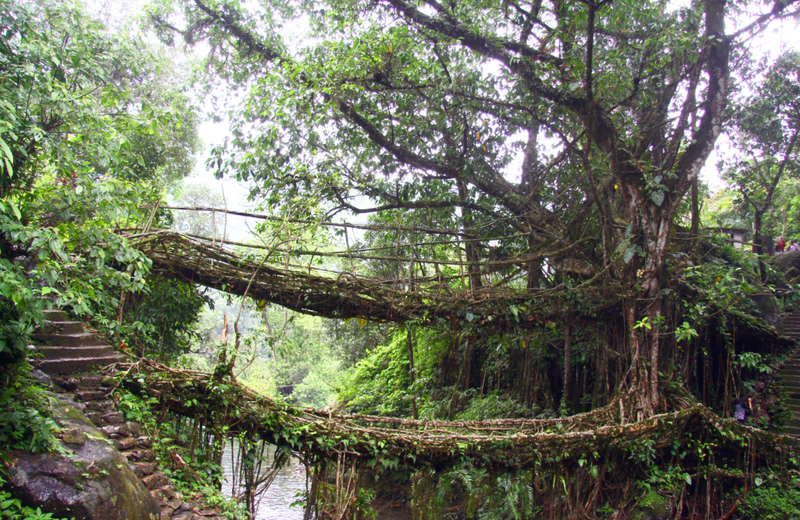
Two closely related tribes, the War-Khasis and the War-Jaintias learned how to make the trees grow their roots in the right direction so that they could use them to create these spectacular bridges and pathways over rivers and through the forest.
Taman Negara Canopy Walkway, Malaysia
Known as the longest canopy walkway, the Taman Negra Canopy Walkway stretches over 1,700 feet and sits 130 feet above the forest ground.

The bridge has become a top tourist attraction in Malaysia. It is advisable to cross only if you are super brave and avoid looking down.
Q’eswachaka Bridge, Peru
This bridge was constructed out of woven grass. There is no need to question its reliability as it has withstood the test of time over the last 500 years when it was first built by the Incas.

The bridge required a lot of work from a big team of people. Women first needed to braid small thin ropes which men then used to braid large support cables. The Keshwa Chaca Bridge is the last known structure from Incan engineering. We are impressed at how much it has held out throughout the years.
Longjiang Suspension Bridge, China
Also called the Long River Bridge, the Longjiang Suspension Bridge is situated outside of Baoshan, Yunnan, China. It connects the cities of Baoshan and Tengchong in west Yunnan and is the tallest and highest suspension bridge in Asia. The construction of the bridge was very intricate and it was completed in 2016 after 5 years.

It stretches over 3,900 feet and suspends 920 feet above the Long River down below. It is one of the longest bridges in the world as well as the tallest. Before its construction, locals had to take an 8.4-mile detour to get from Baishan to Tengchong. Talk about inconvenience!
Capilano Suspension Bridge, Canada
Suspended high above the Capilano river in Northern Vancouver sits the Capilano Suspension Bridge. It stretches 460 feet and sits 230 feet above the water. The bridge gets around 800,000 visitors a year and that’s not surprising given the area. Visitors are gifted with a view of towering evergreens and cedar-scented rainforest air.

It was built originally in 1889 by George Grant MacKay, a Scottish civil engineer. It was sold twice and bought ultimately by Henri Auveneau who renovated the whole bridge in the mid -the 1950s. Fun fact- The bridge has been used as a setting in episodes of several T.V. series, including MacGyver, Sliders, The Crow: Stairway to Heaven, and Psych.
Ai Petri Bridge, Ukraine
With spectacular views all around, the Ai Petri Bridge which sits high up in the mountains of Ukraine crosses over a canyon that is 4,200 feet deep. It serves as a connection between two peaks of the Crimean Mountains.

The bridge gets a lot of wind and fog due to the area it sits in. Even on a calm day, visitors should be careful because the bridge still tends to shake as they cross over the gigantic canyon.
Suspension Glass Bridge, China
Located in the Shiniuzhai National Geological Park of China, this glass bridge stretches 1,410 feet between two mountains. The bridge was constructed in 2015 and cost $3.4 million to build. The bridge was designed by Israeli architect Haim Dotan and has set world records for its architecture and construction.

Following the bridge’s opening, it had to be temporarily closed because it had 10 times the amount of allotted 8,000 visitors per day. Glass bridges have been all the rage in China due to the photo opportunities they provide. The bridge is absolutely stunning but the 984-foot drop will definitely make your stomach drop if you look through the glass bottom.
Plank Road in the Sky, China
I’m not sure this can even constitute a “bridge” as it is literally wooden planks along the edge of Mount Hua in China. It is 7,000 feet high and to be frank, it looks absolutely terrifying!

To cross, you need to connect your harness to the rope that runs along the mountain and grip the chain for dear life as you walk along the edge. And if you run into traffic, you must unclip your harness, pass the other person and then clip back. The view looks unbeatable though!
Cape William Moore Bridge, Alaska
This 100-foot suspension bridge is on the Klondike Highway located near the town of Skagway, Alaska. The bridge was constructed in 1976 to allow traffic to pass over the Moore Creek Gorge.

The bridge is used a lot by trucks that haul ore back and forth. The bridge has reached a point of utter deterioration and there are plans to renew it to perhaps a pedestrian walkway.
Marienbruecke, Germany
Sometimes you give people bridges for their birthday, no? In 1840, Crown Prince Maximilian II built this bridge as a birthday present for his friend Marie. The two climbed mountains together.

It is a pedestrian bridge which is situated over a cliff and is popular with tourists due to its views of Neuschwanstein Castle. The scenery is absolutely breathtaking, both of the castle and of the deep gorge below. While the bridge has since been restored, the original barristers are still used.
Mackinac Bridge, Michigan
The Mackinac bridge, which is also known as “Big Mac,” connects the upper and lower peninsulas of the U.S. state of Michigan. Its construction was complete in 1957 and the bridge spans 26,372 feet.

Since its construction, the bridge, as well as the upper peninsula, has become a major tourist attraction. While this bridge looks very safe (and it usually is) it does tend to receive really strong winds that in severe cases can send cars flying off of it. For those who prefer a different mode of transportation, there is also a ferry service.
Musou Tsuribashi Bridge, Japan
Also known as Japan’s “scariest suspension bridge,” the bridge was built in the 1950s and unfortunately hasn’t been well maintained.

The bridge is located pretty much in the middle of nowhere, in the Southern Japanese Alps called Musou Tsuribashi. It is made only from wire and a few wooden planks with a narrow passage for those daring enough to venture across.
William Preston Lane Bridge, Maryland
Also known as the Chesapeake Bay Bridge, this bridge sits 186 feet above the Chesapeake Bay in Maryland. It stretches for almost 5 miles and carries 24 million cars a year.

In 1967, the bridge was renamed after Lane, the governor of Maryland from 1947 to 1951, who promised to give the state “a system of highways second to none in the nation.” After increased traffic in the area, a parallel bridge was later built-in 1973. The area often sees heavy storms, which makes it difficult for drivers to see well. So definitely be careful.
Kawarau Bridge, New Zealand
A popular attraction, this bridge is 43 meters above the Kawarau River and in the middle of beautiful scenery located near Queenstown. The bridge is mainly used for commercial purposes, with a lot of people coming to bungee jump here.

The bridge is also part of the Queenstown Trail so it also gets used by walkers, runners, and bikers who are passing over the area.
Daedunsan Mountain Suspension Bridge, South Korea
This bridge is part of Daedunsan Provincial Park which is defined by grandiose rock peaks of different summits and lush trees that fill the area.

The setting is absolutely breathtaking, especially in the fall when the leaves have turned their orange-red hue. Definitely bring your camera but be careful with it (and yourself) if you snap some pictures while crossing the 50-meter-long bridge.
Moses Bridg, Netherlands
This bridge was once a moat that guarded a Dutch fortress. It is now a “sunken bridge,” completely disappearing into the landscape and preserving historical accuracy.

The discreet entry to the fort allows visitors to enjoy the area without ruining the moat’s presence. It is made completely out of waterproof wood and the way in which it parts the water is reminiscent of the prophet it is named after. You feel like the waters are parting for you. Luckily, visitors can pass through easier than Moses had it.
Henderson Waves, Singapore
Henderson Waves is the pedestrian bridge in Singapore, standing 36 meters above the ground. Its construction was complete in 2008, unveiling a wavelike curvy shape much like that of a wave.

The bridge is 274-meters in length. The bridge is situated between two parks and is a popular spot among tourists and locals alike who enjoy stunning views of the island.
Mur Island Bridge, Austria
Another pedestrian bridge, the Mur Island Bridge connects both ends of the city of Graz, Austria in order to join the city’s natural and contemporary architecture.

The bridge was built originally in 2003 and meant to be temporary; to honor Graz’s appointment as the European capital of culture. However, due to its popularity among locals and tourists, the city chose to keep the infrastructure intact.
Pont de Singe, England
Now, this is definitely a different twist on your ordinary bridge. The bridge was designed by French artist Olivier Grossetête who used three giant helium balloons to hang a bridge in Tatton Park for the park’s Biennial in 2012.

The bridge is located in the Japanese Garden of the park.
Rakotzbrücke Devil's Bridge, Germany
Nestled among the foliage in Kromlau, Germany’s Kromlauer Park is this arched devil’s bridge known as Rakotzbrücke. It was designed to create a circle when it reflects on the water below it.
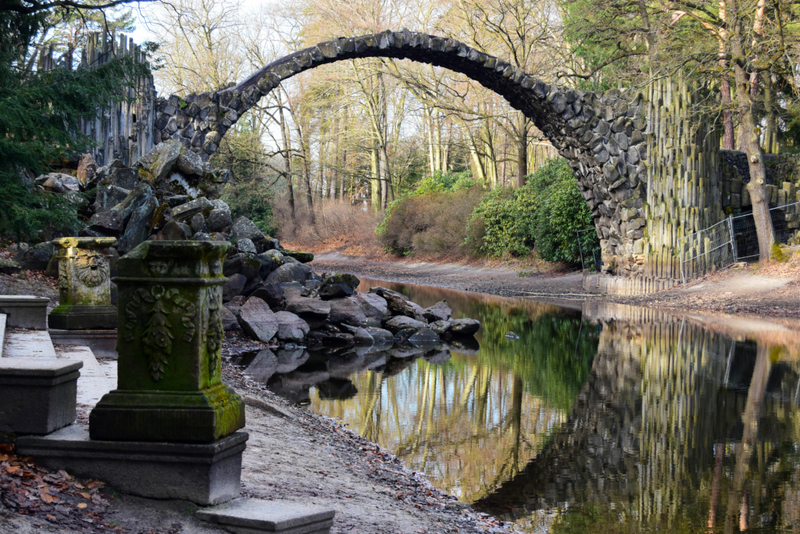
Like many other bridges across Europe, this bridge is also referred to as the “Devil’s Bridge” because it is said that only Satan could create such a magical or dangerous bridge.
Confederation Bridge, New Brunswick
Connecting New Brunswick on the continent with Prince Edward's Island, this bridge is an important part of the Canadian highway system. Interestingly, though, you can only cross it with a car. Cyclists and pedestrians will have to take a ferry to get from the island to the mainland or vice versa.

It is one of Canada’s most impressive engineering constructions and the longest bridge in the world to cross over ice-covered water. It took just a mere 1.3 billion dollars, four years, and five thousand workers for its construction.
Ponte Vasco da Gama, Lisbon
Europe’s second-longest bridge is this steel bridge that crosses the shallow but wide Tagus estuary to bypass Lisbon. The cable-stayed main soak is 1,378 feet and its full length is 7.67 Miles. The base of the Vasco da Gama extends down 95 meters into the bedrock while the pillars were reinforced to support winds of 155mph.

The architects of the bridge have said that it could withstand an earthquake 4 times the strength of the 1755 earthquake.
Pont du Gard, France
A piece of history, this bridge was built between 40 and 60CE and stretches 902 feet over the Gard River in France. It is the highest aqueduct in Roman times at 164 feet and one of the wonders of the ancient world. It supplied water to the city of Nîmes for 5 centuries. It winds between the two cities, over 50 km long through the mountains.

The aqueduct was built with unbelievable precision and is a true marvel of engineering. It was built entirely with dry materials, without the need for any masonry. The Pont du Gard is strikingly beautiful thanks to its elegant forms and natural surroundings that have hardly shown any signs of suffering in the past 20 centuries. This is one of the most visited French monuments every year.
Kintai Bridge, Japan
An all-wood construction bridge, the Kintai Bridge of five arches is made from Japanese zelkova, pine, cypress, chestnut, and oak.

The bridge was constructed in 1673 and renovated in 1950 when the arches were deteriorating. The arches look to be floating up from their solid stone base. Kintai in Japanese means ‘gold brocade sash’.
Slaters' Bridge, Cumbria
This bridge crosses over the River Brathay in Cumbria. It was built in the late 1700’s century.

The bridge is made of arch and slab and used to be on a route which pack-horse used to carry slates from quarries in the hills. The arch stones have a length of up to 4.3ft long. Because of its width of only 4.2ft.
Aqueduct de los Milagros, Spain
The Aqueduct de Los Milagros carried water over the Albarregas River in Spain to the Roman city of Emerita Augusta. It was built shortly after 100CE during the reign of Trajan when Roman engineering was at its peak.

Nowadays, it is favored by storks for nest-building. Its maximum height is 98.5ft and the longest span between piers is 14.8ft.
Carioca Aqueduct, Rio de Janeiro
The Carioca Aqueduct is an aqueduct in the bustling seaside city of Rio de Janeiro in Brazil. Its construction began in 1723 as a means to supply fresh water from the Carioca River to the people of Rio.

It is a magnificent example of colonial architecture and engineering, with its two 42 stories of monumental arches and a height of 57.7 ft. Nowadays, it serves as a bridge for a popular tram that connects the city center with the neighborhood, Santa Teresa.
Bhumibol Bridges, Bangkok
This multi-level spiral interchange above the Chao Phraya River looks more like a rollercoaster than a bridge. This bridge is in the south of Bangkok between the two cable-slated Bhumibol bridges and reaches a height of 164 feet.

The bridge connects the north-south route over the bridges with the western approach. It has a very elegant design, with concrete towers and an elongated diamond shape.
Baliem River Bridge, Western New Guinea
Located above rapid choppy waters of the Baliem river in the Baliem valley, cross this makeshift bridge at your own risk and we definitely won’t judge if you’re too afraid.
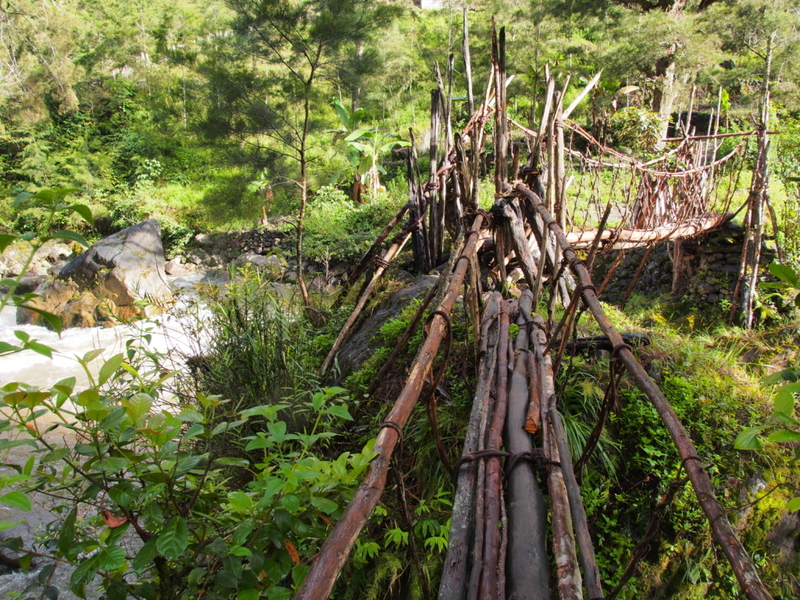
While it does look like the designer of this bridge used an acceptable outline and one which mirrors professional engineering, something about it still isn’t reassuring.
Golden Gate Bridge, San Francisco
One of the most iconic structures in North America, and the number one tourist attraction in San Francisco, the Golden Gate Bridge opened to the public in 1937.

It connects San Francisco to California’s northern counties and spans almost two miles across the Golden Gate, the narrow strait where San Francisco Bay opens to the Pacific Ocean. It has tremendous 746-foot tall towers, Art Deco styling, and signature International Orange color. If you plan to visit, be ready for crowds because the bridge sees about 10 million visitors yearly.
Akashi Kaikyō Bridge, Japan
The Akashi Kaikyo Bridge is a suspension bridge that connects the city of Kobe on the Japanese mainland of Honshu to Iwaya on Awaji island.

It has a length of almost four kilometers and crosses the Akashi strait as part of the Honshu-Shikoku highway. It was opened to the public in 1998.
Sydney Harbour Bridge, Sydney
Nicknamed “The Coathanger” because of its arch-based design, this steel arch bridge crosses over the Sydney harbor and connects the Sydney central business district and the north shore.

The bridge carries traffic from rail, vehicles, bikes, and pedestrians. The dramatic view of the bridge, the harbor, and the closeby Sydney Opera House is an iconic image of Sydney, and likewise, Australia. The bridge’s design was influenced by the Hell Gate Bridge in New York City.
Danyang–Kunshan Grand Bridge, Shanghai
Recognized as the world’s longest bridge, the Danyang-Kunshan Grand Bridge is a 164.8 km long viaduct on the Beijing Shanghai high-speed railway.

Its construction was completed in 2010 after four years of work, 10,000 employees, and $8.5 billion.
Ponte Vecchio, Firenze, Italy
Meaning “old bridge,” the Ponte Vecchio was the only bridge across the Arno in Florence until 1218. The current bridge was rebuilt after a flood in 1345. The bridge is a medieval stone closed-spandrel segmental arch bridge.

During World War II, it was the only bridge across the Arno that the Germans did not destroy. Instead, they obstructed access by demolishing the medieval buildings on each side. Visitors can admire the bridge from underneath where there are occasionally theater presentations, concerts, and boat rides. It also has many shops along it filled with jewelry, art, and souvenirs.
Hangzhou Bay Bridge, China
A highway bridge with a cable-stayed portion across Hangzhou Bay, the Hangzhou Bay Bridge is in the eastern coastal region of China.

It is a large-scale sea-crossing bridge with a length of 36 kilometers. It serves as a connection between the municipalities of Jiaxing and Ningbo in Zhejiang province. Its construction was completed on June 14, 2007, and an opening ceremony was held on June 26, 2007.
Forth Bridge, United Kingdom
Considered a symbol of Scotland and a UNESCO World Heritage Site, the Forth Bridge is a cantilever railway bridge across the Firth of Forth in the east of Scotland, 9 miles west of Edinburgh City Center.
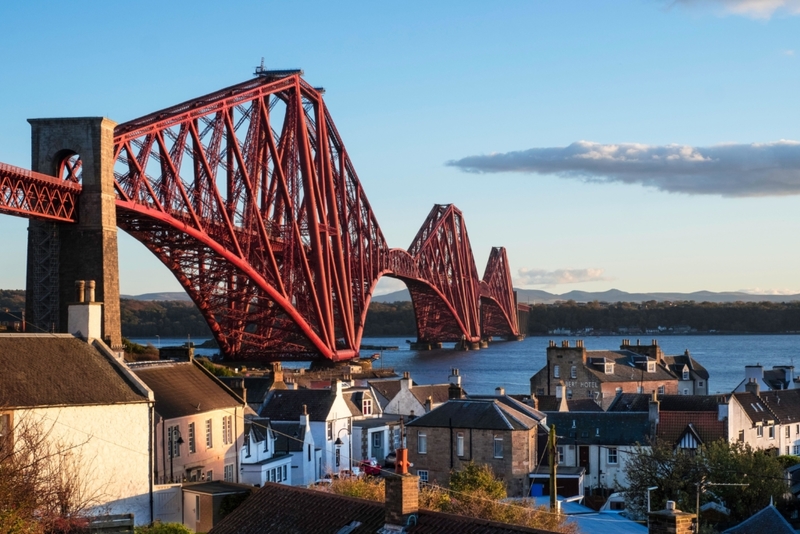
English engineers Sir John Fowler and Sir Benjamin Baker designed the construct. When it opened in 1890, it had the world’s longest span of 541 meters. To this day, it continues to carry passengers and freight. The Forth Bridge marks an important achievement in bridge design and construction during the period when railways were dominating long-distance land travel.
Runyang Yangtze River Bridge, China
The Runyang Yangtze River Bridge is a large bridge complex that stretches over the Yangtze River in Jiangsu Province, China, downstream of Nanjing.

The complex has two major bridges that connect Zhenjiang on the south bank of the river and Yangzhou on the north. The bridge is part of the Yangzhou–Liyang Expressway.
Oresund Bridge, Sweden
The Oresund Bridge provides railway and motorway access across the Øresund strait between Sweden and Denmark.

The bridge spans nearly 8 kilometers from the Swedish coast to the artificial island Peberholm in the middle of the strait.
Duge Bridge, China
The Duge Bridge is a cable-stayed bridge located near Liupanshui in China. As of 2016, the bridge tops all previous records for height with the road deck sitting over 565 meters above the Beipan River. This also makes it the highest cable-stayed bridge.

The bridge crosses the river on the border between Yunnan and Guizhou provinces. No other region on earth has as many high bridges as China’s remote Western Province of Guizhou.
Gateshead Millennium Bridge, England
The Gateshead Millennium Bridge is the world’s first and only tilting bridge. It is used by both pedestrians and cyclists alike and enjoyed by people from all over the world.

The bridge crosses the River Tyne in North East England between the Quayside of Newcastle upon Tyne on the north bank. The bridge was designed by Wilkinson Eyre Architects and engineered by Gifford.
Tsing Ma Bridge, Hong Kong
Tsing Ma Bridge is a bridge in Hong Kong and the world’s 11th-longest span suspension bridge, at 2.16 km.

Tsing Ma Bridge opened to traffic in 1997 and has become a major infrastructure both serving the new airport on Lantau Island and as a tourist attraction. The bridge was named for the two islands it connects, namely Tsing Yi and Ma Wan.
Russky Bridge, Russia
The Russky Bridge is a cable-stayed bridge in Vladivostok, Primorsky Krai, Russia. The bridge is 1,885m long and reaches 70m above sea level and connects Russky Island with the city of Vladivostok.

It is the longest cable-stayed bridge in the world. The bridge cost approximately $1.1 billion and was built in preparation for the 2012 Asia-Pacific Economic Community Summit on Russky Island. Design of the bridge needed to incorporate the extreme climate of the area, which is affected by severe conditions.
Charles Kuonen Suspension Bridge, Switzerland
The Charles Kuonen Suspension Bridge located in Randa, Switzerland, is the longest hanging bridge for pedestrian use in the world. It replaced the Europabrucke which was damaged by a rock slide.

The bridge measures an impressive 494 meters in length and a height of 85 meters above the Grabengufer ravine in Mattertal valley. The designers of the bridge wanted to interfere with nature as little as possible- and they succeeded.
Helix Bridge, Singapore
The Helix Bridge, known officially as The Helix, and previously known as the Double Helix Bridge.
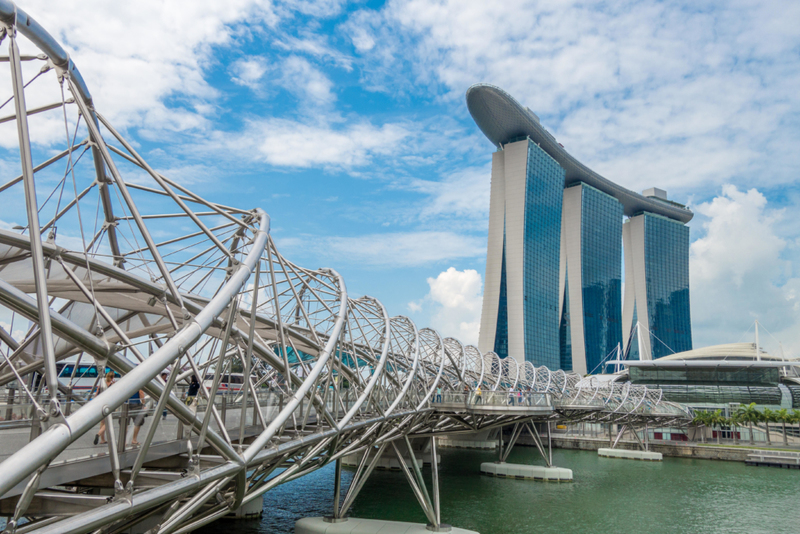
This bridge is a pedestrian bridge that connects Marina Center with Marina South in the Marina Bay area in Singapore.
Bosphorus Bridge, Istanbul, Turkey
The Bosphorus Bridge, called officially the 15 July Martyrs Bridge and unofficially the First Bridge, is one of the three suspension bridges which go across the Bosphorus strait in Istanbul, Turkey, thus connecting Europe and Asia.

Not only does this bridge connect Europe and Asia, but the bridge connects Ortakoy and Beylerbeyi.
Python Bridge, Amsterdam, Netherlands
Python Bridge, officially known as High Bridge, is a bridge that crosses the canal between Sporenburg and Borneo Island in Eastern Docklands, Amsterdam.

It was constructed in 2001 and won the International Footbridge Award in 2002.
Aiguille du Midi Bridge, France
The Aiguille du Midi Bridge is located in France. If you are suffering from any heart disease, then I recommend you skip the plan of crossing this bridge.

It's quite narrow and at a height of about 12600 feet above sea level, it will definitely make your heart beat faster.
Pai Memorial Bridge, Thailand
Located in northern Thailand's Mae Hong Son Province, near the Myanmar border, the Pai Memorial Bridge is one of the main tourist attractions in Pai.
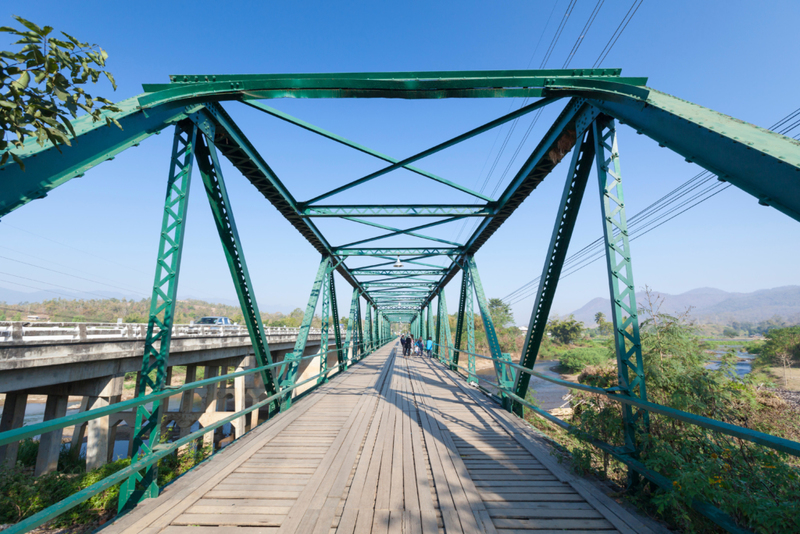
The bridge was made of iron and was originally built by Japanese soldiers during WWII (in 1942) to cross the Pai River.
Linn Cove Viaduct, USA
Located near Linville in North Carolina, USA, the Linn Cove Viaduct is a 1,243-foot (379 m) complex, S-shaped, and undulating balcony across the side of Grandfather Mountain.

This concrete segmental bridge was completed in 1987 over tricky terrain. The view is breathtaking, and the ride is exciting as the bridge appears to be suspended in mid-air. The bridge lies on the Blue Ridge Parkway.
Lakina River Bridge, USA
Located in Valdez-Cordova Census Area, Alaska, the Lakina River Bridge lies at milepost 44.3 of the gravel McCarthy Highway (closed in winters).

The bridge is 190 ft long and the weight limit is 32 Ton.
Borovsko Bridge, Czech Republic
The Borovsko Bridge is an unfinished highway bridge located in Borovnice, in Benešov District in the Central Bohemian Region of the Czech Republic. The bridge is also known as Czech Avignon or Hitler's Bridge. The construction of this never-used highway bridge near Borovsko started in 1939, shortly before WWII as a part of a road called the trans-European corridor.

This 100m tall bridge was finished in 1950. However, highway construction was suspended in the 1950s and the bridge was abandoned. Later was flooded by the drinking water reservoir built in 1976. Access to vehicle cars is totally forbidden.
Deosai Bridge, Pakistan
Located on the Deosai Park Road in Skardu Gilgit-Baltistan province, in northern Pakistan, the road has a length of 82.4 km. It includes gravel, asphalt, a river crossing, and one of the scariest wood bridges in the world.

The road runs at an average altitude of 4,114 meters (13,497 feet) above sea level. It’s located in the Deosai Plains, the second highest plateau in the world, after the adjoining Tibetan Plateau, between the ridge of the Himalayas and Karakoram
Khurgan and Khoton Lakes Bridge, Mongolia
Located in the northern part of the Altai mountain range, near the Chinese border, in Bayan-Ölgii, the westernmost of the provinces of Mongolia, the bridge over the Khurgan and Khoton Lakes is a short wooden bridge.

Impassable for 2 cars at the same time, this 100m bridge tests the skill, and courage, of any driver. The bridge spans the Khurgan and Khoton Lakes, at an elevation of more than 2.000m.
Drake Bay Bridge, Costa Rica
Located on the Osa Peninsula, Puntarenas Province, in Costa Rica the bridge over the Progreso river lies in the Golfo Dulce Forest Reserve and is located on the way from Drake Bay Airport to Drake Bay.

The bridge is simply terrible and those who choose to cross, they need to tread lightly.
Danyore Suspension Bridge, Pakistan
Located in Gilgit-Baltistan, in the Northern Areas of Pakistan, the Danyore Suspension Bridge is a 510-feet-long bridge connected to a 10-meter curve tunnel. Dubbed “Pul-e-Sirat” (the bridge between heaven and hell), the bridge connects Gilgit to Danyore across the River Hunza and was constructed in the mid-sixties.

Currently, the bridge is closed for vehicles and only pedestrians are allowed to pass through after being declared unsafe by the district administration. Locals say the journey is a test of a driver’s skill and nerve and add that an abrupt stop can leave a vehicle stranded in the middle of the stream, “which is a quite a frightening situation”.
Mike O'Callaghan, Pat Tillman Memorial Bridge, USA
The Mike O'Callaghan–Pat Tillman Memorial Bridge, nicknamed the Hoover Dam Bypass, is an arch bridge that spans the Colorado River. Stay away if you're scared of heights.

At 880 feet over the Colorado River, it is the second-highest bridge in the United States and the highest concrete-arch bridge anywhere. The bridge, located between the states of Arizona and Nevada is 579 m long and was opened in 2010.
Annai Indira Gandhi Road Bridge, India
Located in the South Indian state of Tamil Nadu, the Annai Indira Gandhi Road Bridge connects the National Highway (NH 49) with Rameswaram on Pamban Island. The bridge is 2.345km long. The road over the bridge is asphalted and is also known as the Pamban Bridge. It is the longest bridge in southern India.

It took close to 14 years to be completed. The bridge is located in the world's second most corrosive environment after Florida, making its maintenance a challenging job. The location is also a cyclone-prone high wind velocity zone. The construction of this bridge has left many engineers wondering as it stands tall and strong even today. The ships too can pass under the bridge and hence it is the most convenient means of commutation.
Cuyuni River Bridge, Venezuela
Located in eastern Venezuela, the Cuyuni River bridge is said to be designed by the famous Gustave Eiffel.

The iron bridge over the Cuyuni River is 170 m. The road to the bridge is the gravel Ruta 10.
Rio–Antirrio Bridge, Greece
Built in an area with high seismicity, the Rio–Antirrio bridge is an engineering marvel spanning the Gulf of Corinth, in Greece. It opened in August 2004. It’s truly an architectural and engineering marvel, which had to overcome an exceptional combination of adverse environmental conditions.

Due to the peculiar conditions of the straits, several unique engineering problems needed to be considered and overcome: deep water (65 m), insecure materials for foundations, withstanding strong winds up to 180 km/hr, seismic activity, the probability of tsunamis, and tectonic movement.
Skippers Bridge, New Zealand
Located in the southwest of New Zealand's South Island, the Skippers suspension bridge is 96 m long and 90 m high. The building of this bridge was done as early as 1866. It crossed the river only 6 meters above the water and was prone to damage from flooding.

It was replaced in 1871 but rebuilt in the same place. The speed limit is 15km/h. One vehicle on the bridge at any one time. The bridge limit is 2.500kg. The bridge is 91.4 meters above the river, making it the highest suspension bridge in New Zealand. This single-lane traffic bridge is 2.2m-wide and its span is 96.3m. The deck and stiffening truss were constructed in timber.
Puente del Rio Electrico, Argentina
Located within the Los Glaciares National Park in Santa Cruz Province of Argentina.

Puente del Rio Electrico is a short wood bridge located on the road Ruta Provincial23, near the Chilean border over the Electrico River. The bridge is 35m long.
Island Bridge, Mozambique
Mozambique Island Bridge is a historically significant concrete bridge linking the Mozambican mainland and "Ilha de Moçambique"(Mozambique Island).

The bridge is 3,800 meters (12,500 ft) over the Indian Ocean. It’s a one-lane bridge and was built in 1967.